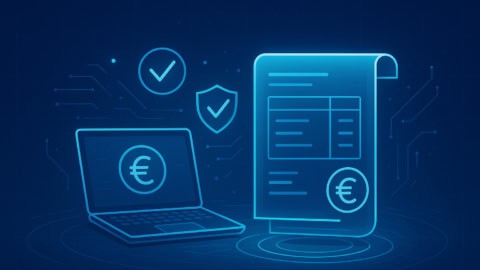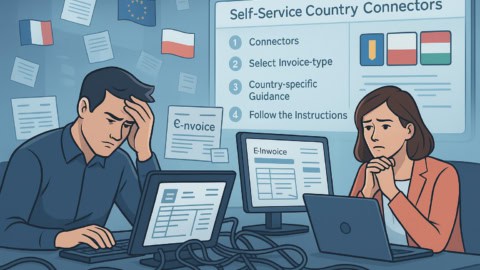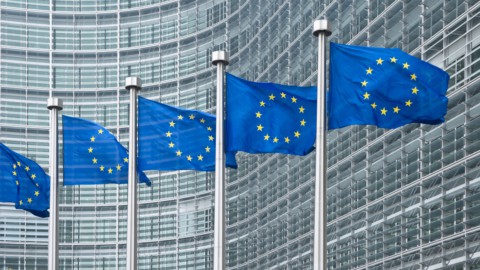In a move mirroring recent e-invoicing legislation changes in other European countries, Romania has been taking steps towards refining its own e-invoicing regulations in recent years. These changes have brought about distinct advantages for both businesses and government, from boosting the efficacy of B2G and B2B transactions to increasing transparency.
E-invoicing in Romania: the story so far
The gradual implementation of B2B and B2G electronic invoicing in Romania first started to take shape back in September 2021, when the country’s Ministry of Public Finance published a draft on the enablement of B2G e-invoicing via an existing national system called RO e-Factura. RO e-Factura is an IT system for reporting, storing and downloading invoices through the ANAF (The National Agency for Fiscal Administration) server.
The implementation of e-invoicing via RO e-Factura took place during a pilot programme, created to test B2G e-invoicing within the system. E-invoicing became operational from 1 October that same year under Ordinance no. 120/2021, which regulated the e-Factura system.
By December 2021, the country was taking its first steps towards a nationwide e-invoicing mandate, with Order no. 1366/2021 from 5 November 2021 approving the technical specifications and basic elements of the e-invoicing format RO_CIUS nationwide. At this stage, B2G e-invoicing was optional for taxpayers, as was B2B e-invoicing, but solely under the condition that both senders and recipients of the e-invoice were registered in the e-Factura registry.
In January 2022 Romania announced a move away from the voluntary use of e-invoicing, stating that B2B taxpayers supplying high tax risk products – products which bring about a high risk of tax fraud and evasion – would be obliged to use electronic invoices using the RO e-Factura system from 1 July 2022.
Products which fall under the category “high tax risk” (i.e. susceptible to tax evasion) include:
- Fruit and vegetables
- Alcohol
- Construction materials
- Mineral products
- Clothing and footwear
In January 2022, Romania applied to the EU commission for a derogation in order to bring about obligatory e-invoicing via the country’s e-Factura invoicing system for all transactions carried out between taxpayers in the Romanian territory. In order to enforce mandatory e-invoicing, the country’s government requested authorisation from the European Commission to apply an exception to Articles 178, 218, and 232 of Directive 2006/112/EC on VAT.
On 1 July 2022 Romania announced that:
- Romanian taxpayers were obligated to issue e-invoices for B2G transactions via RO e-Factura
- Taxpayers supplying or receiving high tax risk products as part of a B2B arrangement would be obliged to use e-invoices via RO e-Factura
In June 2023, it was announced that the European Commission had published a draft authorising the implementation of mandatory B2B electronic invoicing in Romania from 1 January 2024. This authorisation will remain in place for three years (from January 2024 until December 2026) or until the ViDA (VAT in the Digital Age) proposal is adopted by the EU.
What is ViDA?
ViDA (VAT in the Digital Age) is a strategy put together by the EU Commission to ensure fair and straightforward taxation for businesses. It outlines how tax authorities can utilise technology to combat tax evasion and fraud, help organisations and ensure that current VAT legislation is appropriate and necessary for businesses operating in the digital age.
On 19 September 2023 a draft decree was published which stated that the shift to a clearance model in Romania will be pushed back to 1 July 2024. Between 1 January 2024 and 1 July 2024 Romanian taxpayers will need to send their invoice to the e-Factura platform within five days of issue.
Current Romanian e-invoicing requirements
At the time of writing, all Romanian companies supplying high tax risk products are mandated to issue e-invoices using the RO e-Factura system
As we’ve seen, since July 2022 there has been a mandate in Romania for all companies that supply high tax risk products to other businesses to use the national e-Factura infrastructure for the issuing of e-invoices.
Additionally, regulation changes are expected that will see obligatory e-invoicing for all Romanian businesses from 2024.
Upcoming changes
From 1 July 2024, there will be mandatory e-invoicing for all B2B transactions across Romania using the RO e-Factura system, in addition to the existing requirement for B2G e-invoicing and B2B e-invoicing for high tax risk products.
From the start of 2024 until this deadline, taxpayers will need to send invoices to the e-Factura platform within five days of issue.
How to prepare for the changes
Here’s a short list of what your business can do now in preparation for the changes to Romanian e-invoicing regulations…
1) Review your current resources
Before making any decisions as to your preferred e-invoicing solution, it’s important to conduct a thorough audit of your internal resources – both technical and human. When performing an internal inventory, ask yourself the following questions:
- On average, how many invoices is the company sending and receiving every month?
- Does our current e-invoicing solution depend on a few individuals with specific knowledge?
- How easily could our current e-invoicing solution be adapted to work with the RO e-Factura system?
- How informed are the relevant individuals on the upcoming regulatory changes regarding invoicing in Romania?
2) Avoid short term thinking
While it’s important to prepare your company and employees for the upcoming regulatory changes, it would be foolhardy to assume that these are the last e-invoicing regulatory changes your company will need to adapt to. In fact, e-invoicing requirements are only likely to become more complex as your partner network expands and governments introduce increasingly specific regulations.
To ensure you’re fully prepared for whatever changes might affect your business in the future, it’s worth selecting a flexible e-invoicing tool that is able to adapt to your specific needs. For those businesses without extensive in-house e-invoicing expertise, this almost certainly means outsourcing effort and responsibility to an external e-invoicing solutions provider such as ecosio.
3) Don’t leave it to the last minute
The implementation of a new e-invoicing solution can seem like an inconvenience that some businesses may be tempted to postpone. However, doing so only causes bigger issues later on. You’ll need to update your e-invoicing system at some point, and leaving it to the last minute means you have less time to fully evaluate the available options, and a much greater chance of choosing an ill-fitting solution.
For these reasons, we strongly recommend taking the time to investigate the best e-invoicing solutions for you as early as possible. As well as avoiding the unwanted disruption caused by leaving it too late, we’ve also found that companies who prioritise choosing their new e-invoicing tool in a timely manner reap many benefits from doing so – from saving time and money to reducing risk and boosting competitive advantage. Try to see the implementation of a new e-invoicing solution as an opportunity to enhance your current business strategy and boost efficiency moving forward.
4) Stay abreast of e-invoicing developments
E-invoicing regulations are constantly being updated the world over. As a result, staying ahead of the changes can seem like rather a daunting task. But don’t worry! With ecosio’s e-invoicing newsletter you can get global e-invoicing updates straight to your inbox. Simply enter your details and you’ll be among the first to hear of all the latest developments in the field as and when they happen.
Three things to consider when selecting an e-invoicing provider
When evaluating different e-invoicing solution providers, asking the following questions should help you determine which one is a good fit for your company:
1) Can they streamline the entire e-invoicing process?
While some e-invoicing solution providers, like ecosio, offer a fully managed service, others require companies to take on some of the internal tasks required to achieve a streamlined e-invoicing process themselves. Before committing to a solution, be sure to get a full rundown of exactly what the e-invoicing service is prepared to offer and how much additional internal work will be required from your team.
2) Do they provide an API connection?
By connecting to your EDI provider via API, it’s possible for invoicing data to be seamlessly and automatically sent to and from your internal accounting system or ERP. This significantly improves data visibility and accessibility for internal teams, in turn reducing the likelihood of errors occurring.
For more information on the benefits of such an approach, see our detailed article on the benefits of conducting EDI via API.
3) Are they a certified Peppol Access Point?
As compliance with Peppol is already a mandatory requirement in many countries, selecting an e-invoicing solution provider that is also a certified Peppol Access Point (as ecosio is) is important.
Without access to the Peppol network, you will be unable to meet e-invoicing requirements in many countries and will therefore need to enlist the help of another e-invoicing solution provider should you wish to do business in those areas in the future.
Conclusion
Hopefully this breakdown of e-invoicing in Romania has provided you with the information you need to prepare your team for the upcoming regulation changes.
To ensure you don’t miss any further updates, register now for the ecosio e-invoicing newsletter. You’ll get the latest e-invoicing news straight to your inbox!














